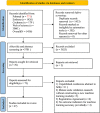Prediction performance of the machine learning model in predicting mortality risk in patients with traumatic brain injuries: a systematic review and meta-analysis
- PMID: 37507752
- PMCID: PMC10385965
- DOI: 10.1186/s12911-023-02247-8
Prediction performance of the machine learning model in predicting mortality risk in patients with traumatic brain injuries: a systematic review and meta-analysis
Abstract
Purpose: With the in-depth application of machine learning(ML) in clinical practice, it has been used to predict the mortality risk in patients with traumatic brain injuries(TBI). However, there are disputes over its predictive accuracy. Therefore, we implemented this systematic review and meta-analysis, to explore the predictive value of ML for TBI.
Methodology: We systematically retrieved literature published in PubMed, Embase.com, Cochrane, and Web of Science as of November 27, 2022. The prediction model risk of bias(ROB) assessment tool (PROBAST) was used to assess the ROB of models and the applicability of reviewed questions. The random-effects model was adopted for the meta-analysis of the C-index and accuracy of ML models, and a bivariate mixed-effects model for the meta-analysis of the sensitivity and specificity.
Result: A total of 47 papers were eligible, including 156 model, with 122 newly developed ML models and 34 clinically recommended mature tools. There were 98 ML models predicting the in-hospital mortality in patients with TBI; the pooled C-index, sensitivity, and specificity were 0.86 (95% CI: 0.84, 0.87), 0.79 (95% CI: 0.75, 0.82), and 0.89 (95% CI: 0.86, 0.92), respectively. There were 24 ML models predicting the out-of-hospital mortality; the pooled C-index, sensitivity, and specificity were 0.83 (95% CI: 0.81, 0.85), 0.74 (95% CI: 0.67, 0.81), and 0.75 (95% CI: 0.66, 0.82), respectively. According to multivariate analysis, GCS score, age, CT classification, pupil size/light reflex, glucose, and systolic blood pressure (SBP) exerted the greatest impact on the model performance.
Conclusion: According to the systematic review and meta-analysis, ML models are relatively accurate in predicting the mortality of TBI. A single model often outperforms traditional scoring tools, but the pooled accuracy of models is close to that of traditional scoring tools. The key factors related to model performance include the accepted clinical variables of TBI and the use of CT imaging.
Keywords: Machine learning; Meta-analysis; Mortality rate; Prediction; Systematic review; Traumatic brain injury.
© 2023. The Author(s).
Conflict of interest statement
The authors declare no competing interests.
Figures





Similar articles
-
Early Prediction of Mortality Risk in Acute Respiratory Distress Syndrome: Systematic Review and Meta-Analysis.J Med Internet Res. 2025 May 20;27:e70537. doi: 10.2196/70537. J Med Internet Res. 2025. PMID: 40392588 Free PMC article.
-
Machine learning for the prediction of sepsis-related death: a systematic review and meta-analysis.BMC Med Inform Decis Mak. 2023 Dec 11;23(1):283. doi: 10.1186/s12911-023-02383-1. BMC Med Inform Decis Mak. 2023. PMID: 38082381 Free PMC article.
-
The predictive value of machine learning for mortality risk in patients with acute coronary syndromes: a systematic review and meta-analysis.Eur J Med Res. 2023 Oct 20;28(1):451. doi: 10.1186/s40001-023-01027-4. Eur J Med Res. 2023. PMID: 37864271 Free PMC article.
-
Prediction of in-hospital mortality in patients on mechanical ventilation post traumatic brain injury: machine learning approach.BMC Med Inform Decis Mak. 2020 Dec 14;20(1):336. doi: 10.1186/s12911-020-01363-z. BMC Med Inform Decis Mak. 2020. PMID: 33317528 Free PMC article.
-
The predictive accuracy of machine learning for the risk of death in HIV patients: a systematic review and meta-analysis.BMC Infect Dis. 2024 May 6;24(1):474. doi: 10.1186/s12879-024-09368-z. BMC Infect Dis. 2024. PMID: 38711068 Free PMC article.
Cited by
-
An algorithm to assess importance of predictors in systematic reviews of prediction models: a case study with simulations.BMC Med Res Methodol. 2025 Feb 14;25(1):38. doi: 10.1186/s12874-025-02492-7. BMC Med Res Methodol. 2025. PMID: 39953476 Free PMC article.
-
A Meta-analysis of Predicting Disorders of Consciousness After Traumatic Brain Injury by Machine Learning Models.Alpha Psychiatry. 2024 Jun 1;25(3):290-303. doi: 10.5152/alphapsychiatry.2024.231443. eCollection 2024 Jun. Alpha Psychiatry. 2024. PMID: 39148604 Free PMC article.
-
Developing practical machine learning survival models to identify high-risk patients for in-hospital mortality following traumatic brain injury.Sci Rep. 2025 Feb 18;15(1):5913. doi: 10.1038/s41598-025-89574-0. Sci Rep. 2025. PMID: 39966448 Free PMC article.
-
Probability density and information entropy of machine learning derived intracranial pressure predictions.PLoS One. 2024 Jul 1;19(7):e0306028. doi: 10.1371/journal.pone.0306028. eCollection 2024. PLoS One. 2024. PMID: 38950055 Free PMC article.
References
-
- Dewan MC, Rattani A, Gupta S, Baticulon RE, Hung YC, Punchak M, Agrawal A, Adeleye AO, Shrime MG, Rubiano AM et al. Estimating the global incidence of traumatic brain injury. J Neurosurg 2018;130(4):1080–97. - PubMed
-
- De Silva MJ, Roberts I, Perel P, Edwards P, Kenward MG, Fernandes J, Shakur H, Patel V. Patient outcome after traumatic brain injury in high-, middle- and low-income countries: analysis of data on 8927 patients in 46 countries. Int J Epidemiol. 2009;38(2):452–8. doi: 10.1093/ije/dyn189. - DOI - PubMed
Publication types
MeSH terms
LinkOut - more resources
Full Text Sources
Medical

